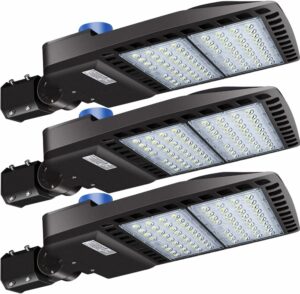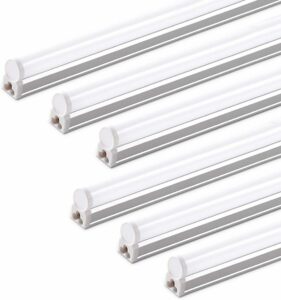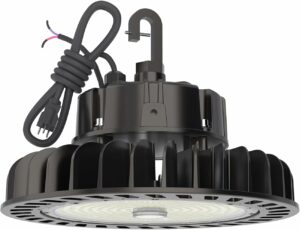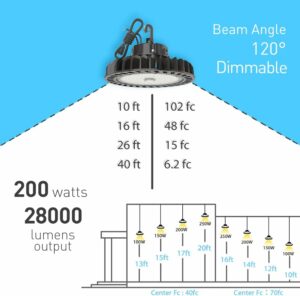A Comparison of LED vs. Fluorescent Lighting
Introduction
In a world increasingly focused on sustainable and energy-efficient solutions, the choice of lighting technology plays a pivotal role in shaping our environments.
As we navigate the myriad options available, two contenders stand out prominently: Light-emitting diode (LED) and Fluorescent lighting.
The significance of well-designed lighting goes beyond mere illumination; it affects our productivity, mood, and the overall aesthetics of spaces, whether in residential, commercial, or industrial settings.
Provo Green Products embodies a beacon of trust in sustainable discoveries, offering choices that enhance your life and leave a positive mark on our planet.
Leveraging extensive expertise in manufacturing, construction, and various trades, we provide a solid foundation for sustainable living.
Our meticulous research process guarantees that our information about each product is precise and current, allowing you to make informed decisions.
Whether your interest lies in solar products, electric bikes, or other eco-friendly alternatives, our commitment to credibility ensures you have access to dependable insights, guiding your journey toward a more sustainable lifestyle.
Provo Green Products is your go-to destination for finding the right green products for your lifestyle.
Disclosure: As an Amazon Associate, we may earn from qualifying purchases. This does not affect the product pricing whatsoever.
Setting the Stage
In this comprehensive comparison, we delve into the intricate details of LED and fluorescent lighting technologies, shedding light on their unique attributes and helping you make an informed decision.
Understanding the intricacies of these lighting systems is crucial for individuals seeking the most cost-effective and energy-efficient solutions and businesses looking to optimize their lighting infrastructure.
The Emergence of LED and Fluorescent Technologies
The emergence of LED and fluorescent lighting technologies has revolutionized the traditional lighting landscape.
While incandescent bulbs were once the norm, these newer technologies offer a more energy-efficient alternative.
With their semiconductor-based design and fluorescents harnessing the power of phosphorescent coatings, LEDs represent the forefront of contemporary lighting solutions.
Purpose of the Comparison
As we begin this exploration, our primary objective is to help you understand the strengths and weaknesses of LED and fluorescent lighting.
This comparison goes beyond the surface, aiming to unravel the intricacies of each technology, empowering you to make choices that align with your unique needs, preferences, and sustainability goals.
Technology Overview
Understanding the Heart of LEDs
Light-emitting diode (LED) technology represents a breakthrough in the world of illumination.
At its core, an LED is a semiconductor device that emits light when an electric current passes through it.
Unlike traditional incandescent bulbs that rely on heating a filament to produce light, LEDs generate illumination through the movement of electrons in a semiconductor material.
This process makes LEDs more energy-efficient and extends their lifespan significantly.
Components and Functioning of LED Lights
LEDs consist of several key components working in harmony. A semiconductor diode is the LED’s heart, allowing the current to flow in one direction.
The diode is encapsulated in a lens, often made of epoxy, which focuses the light and protects the semiconductor.
Using a heat sink ensures that excess heat generated during operation is effectively dissipated, contributing to the longevity of the LED.
Key Benefits of LED Technology
LED technology boasts numerous advantages. Chief among them is energy efficiency, with LEDs consuming significantly less power than traditional lighting sources.
The longevity of LEDs is another notable feature, as they can last tens of thousands of hours, reducing the frequency of replacements.
LEDs are also renowned for their instant illumination, reaching full brightness without the warm-up time required by certain other technologies.
Challenges and Drawbacks
While LED technology has witnessed remarkable advancements, it has its challenges.
Initial costs can be higher compared to traditional lighting options, although the long-term savings in energy consumption and maintenance costs often outweigh the upfront investment.
Additionally, concerns have been raised about the potential environmental impact of manufacturing and disposing of LED products, prompting ongoing efforts to improve sustainability in the industry.
Exploring Fluorescent Technology
Fluorescent lighting, on the other hand, relies on a different set of principles to produce light.
A gas discharge process is at the core of fluorescent technology.
When an electric current passes through a tube containing mercury vapor and phosphor coating, ultraviolet (UV) light is produced.
This UV light interacts with the phosphor coating, resulting in the emission of visible light.
Components and Functioning of Fluorescent Lights
Fluorescent lights consist of a few key components.
The tube, often called a lamp, contains a small amount of mercury vapor and is coated with phosphor.
Electrodes at each end of the tube initiate the current flow through the gas, triggering the production of UV light.
The phosphor coating, in turn, converts the UV light into visible light, providing illumination.
Key Benefits of Fluorescent Technology
Fluorescent lighting has been a popular choice for decades due to its energy efficiency compared to incandescent lighting.
The relatively low operating temperatures of fluorescent lights contribute to their longer lifespan.
Additionally, fluorescent lights can produce a diffuse, soft light well-suited for various applications.
Challenges and Drawbacks
Despite its advantages, fluorescent lighting has faced criticism for its environmental impact, primarily due to the mercury content in the tubes.
The presence of mercury raises concerns about proper disposal and recycling practices to prevent environmental harm.
Additionally, fluorescent lights may exhibit a warm-up period, during which they reach full brightness, and some individuals may find the light quality less preferable compared to alternatives.
Understanding the intricate workings of both LED and fluorescent technologies sets the stage for a comprehensive comparison. In the following sections, we will delve deeper into energy efficiency, cost analysis, and application suitability to provide a holistic view of these lighting solutions.

Energy Efficiency
LEDs: Pioneering Energy Efficiency
One of the standout features of LED lighting is its exceptional energy efficiency.
LEDs convert a higher percentage of electrical power into visible light, minimizing wasted energy in the form of heat.
This efficiency is attributed to the semiconductor diode’s ability to emit light when electrons recombine, which releases energy from photons.
Unlike traditional incandescent bulbs, where a significant portion of energy is lost as heat, LEDs focus on light production, making them a more sustainable choice.
Comparing Luminous Efficacy
Luminous efficacy, measured in lumens per watt, is a critical metric for evaluating the efficiency of lighting technologies. LEDs consistently demonstrate higher luminous efficacy than fluorescent lights.
The efficiency of LEDs continues to improve with advancements in technology, contributing to their widespread adoption in various applications, from residential lighting to large-scale commercial installations.
Fluorescent Lights: A Legacy of Efficiency
Fluorescent lighting has long been recognized for its energy-efficient characteristics compared to traditional incandescent bulbs.
The gas discharge process inherent in fluorescent technology results in a more efficient conversion of electrical energy into visible light.
While not as efficient as LEDs, fluorescents still substantially improve energy utilization, making them a popular choice in environments where energy conservation is a priority.
Understanding System Efficiency
Energy efficiency extends beyond the performance of individual bulbs to encompass the entire lighting system.
LED lighting excels in system efficiency due to its directional nature.
LEDs emit light in a specific direction, reducing the need for reflectors and diffusers that can absorb and scatter light.
This focused illumination enhances the overall efficiency of the lighting system, making LEDs particularly suitable for applications where precise and targeted lighting is essential.
Environmental Impact Considerations
The energy efficiency of lighting technologies directly influences their environmental impact.
LED lights, with their lower energy consumption and longer lifespan, contribute to reduced carbon emissions over their lifetime.
Additionally, advancements in LED manufacturing techniques aim to minimize environmental impacts associated with production and disposal.
Fluorescent Lights and Mercury Concerns
While fluorescent lighting is energy-efficient, mercury in fluorescent tubes raises environmental concerns.
Mercury is a hazardous substance that requires proper handling and disposal to prevent environmental contamination.
Efforts within the industry focus on developing mercury-free alternatives and improving recycling processes to mitigate the environmental impact of fluorescent lighting.
As we navigate the terrain of energy efficiency, it becomes evident that both LED and fluorescent lighting offer significant advantages compared to traditional incandescent options.
The following section delves into the economic aspect of these technologies, exploring the upfront costs, operational expenses, and overall cost-effectiveness associated with LED and fluorescent lighting systems.

Cost Analysis
Upfront Costs of LED Technology
While renowned for its energy efficiency and longevity, LED lighting often comes with higher upfront costs than traditional lighting options.
The initial investment in LED bulbs and fixtures can be a deterrent for some consumers and businesses.
However, it’s crucial to consider this cost in the context of LEDs’ long-term benefits, including energy savings, reduced maintenance expenses, and an extended operational lifespan.
Long-Term Savings and Operational Costs
The actual economic advantage of LED lighting emerges when considering long-term savings.
LEDs consume significantly less energy than traditional incandescent and fluorescent bulbs, lowering electricity bills over time.
The extended lifespan of LEDs further contributes to cost savings by reducing the frequency of replacements and associated maintenance costs.
While the initial investment may be higher, the overall cost-effectiveness of LED technology becomes evident when considering these factors.
Return on Investment (ROI) Considerations
Calculating the return on investment is integral to assessing the cost-effectiveness of LED lighting.
Although the initial costs may be higher, the energy savings and reduced maintenance expenses can lead to a quicker payback period.
Businesses and homeowners often find that the long-term benefits outweigh the upfront investment, making LEDs a financially sound choice.
Fluorescent Lights: Balancing Upfront and Operational Costs
Fluorescent lighting, on the other hand, generally has lower upfront costs compared to LEDs.
The affordability of fluorescent bulbs and fixtures has contributed to their widespread use in various settings.
However, it’s essential to consider the operational costs over time.
While fluorescents are more energy-efficient than incandescent bulbs, they consume more power than LEDs and have a shorter lifespan.
Replacement Costs and Maintenance
Fluorescent lights have a shorter operational lifespan compared to LEDs.
Frequent replacements can incur additional costs over time, not only in purchasing new bulbs but also in the labor required for replacements.
The need for more frequent maintenance can be a significant factor in assessing the overall cost of fluorescent lighting systems.
Environmental Considerations
In addition to financial considerations, the environmental impact of lighting choices is a growing concern.
LED technology’s lower energy consumption and longer lifespan contribute to reduced waste and lower carbon emissions over time.
On the other hand, the environmental impact of fluorescent lighting is influenced by the disposal challenges associated with mercury-containing tubes.
Navigating the Decision-Making Process
As consumers and businesses navigate the decision-making process, weighing the upfront costs against long-term savings is crucial.
Factors such as energy efficiency, lifespan, and maintenance expenses play integral roles in determining the overall cost-effectiveness of LED and fluorescent lighting systems.
In the following section, we delve into the practical aspects of these technologies, exploring their applications and suitability for various settings.

Application and Suitability
Versatility of LED Technology
LED lighting’s versatility makes it suitable for various applications, from residential to commercial and industrial applications.
The directional nature of LED light emission allows for precise control, making it ideal for task lighting, accent lighting, and architectural applications.
LEDs are available in a spectrum of color temperatures, providing flexibility in creating different atmospheres, whether it’s a warm and inviting ambiance for a living room or a cool, focused light for a workspace.
Residential Lighting
In residential settings, LED lighting has gained popularity for its ability to create aesthetically pleasing environments while offering energy efficiency.
LED bulbs are available in various shapes and sizes, making them suitable for various fixtures.
The instant-on feature of LEDs ensures immediate illumination without the warm-up time associated with some other technologies.
Commercial and Industrial Applications
LED lighting’s energy efficiency and longevity make it a preferred choice in commercial and industrial settings.
LEDs provide reliable and cost-effective illumination from offices and retail spaces to warehouses and manufacturing facilities.
LED light’s focused and directional nature is advantageous in specific areas that need targeted lighting, such as retail displays or production lines.
Outdoor Lighting
LED technology’s durability and resistance to environmental factors make it well-suited for outdoor lighting applications.
From streetlights to architectural lighting on facades, LEDs offer longevity and reduced maintenance requirements.
The ability to control the direction and intensity of light enhances their effectiveness in outdoor settings.
Fluorescent Lighting in Commercial Spaces
Fluorescent lighting has historically been a common choice for commercial spaces, including offices, schools, and healthcare facilities.
Fluorescents provide diffuse, even lighting, making them suitable for large areas with general lighting needs.
However, the warm-up time and the potential for flickering in certain fluorescent lights may impact their suitability for spaces where instant and consistent illumination is crucial.
Considerations for Specific Environments
When considering the suitability of LED and fluorescent lighting, factors such as color temperature, color rendering index (CRI), and flicker characteristics come into play.
LED lighting offers a broader range of color temperatures, allowing customization to match the desired ambiance.
High CRI values in LEDs contribute to accurate color representation.
On the other hand, fluorescent lights may have limitations, influencing their appropriateness for specific environments.
Adaptability to Dimming and Controls
The adaptability of LED and fluorescent lighting to dimming and advanced controls is a crucial aspect of their suitability for various applications.
With their inherent compatibility with dimmers and intelligent lighting systems, LEDs offer precise control over light levels.
While some fluorescent lights can be dimmed, they may require specific ballasts and may not achieve the same level of performance as LEDs in this regard.
Tailoring Lighting Solutions to Specific Needs
The choice between LED and fluorescent lighting depends on the specific needs and characteristics of the environment.
LED technology’s versatility, energy efficiency, and adaptability to various applications make it a compelling choice for various settings.
Fluorescent lighting, while still prevalent in specific spaces, may be best suited for environments where the unique characteristics of this technology align with the requirements.
Understanding the distinct advantages and considerations of LED and fluorescent lighting enables consumers and businesses to make informed decisions based on their priorities and preferences.

Conclusion
In the ever-evolving landscape of lighting technologies, comparing LED and fluorescent lighting reveals a dynamic interplay of efficiency, cost-effectiveness, and suitability for diverse applications.
LED technology emerges as a frontrunner, showcasing unparalleled energy efficiency, extended lifespan, and adaptability to various settings.
Its versatility, ranging from residential to commercial and outdoor applications, positions LEDs as a modern and sustainable lighting solution.
While fluorescent lighting continues to hold its ground, especially in established commercial spaces, considerations such as warm-up time, environmental impact, and evolving LED advancements prompt reevaluating its long-standing dominance.
Stay in Touch!
I’am a dedicated entrepreneur with many years of experience and an integrity-driven individual who is highly motivated to succeed. Leveraging extensive expertise in manufacturing, construction, and various trades, we can provide a solid foundation for sustainable living. Our meticulous research process guarantees that our information about each product is precise and current, allowing you to make informed decisions. A deep understanding of business operations empowers me to consistently implement improvements that result in ongoing success. Visit site.
